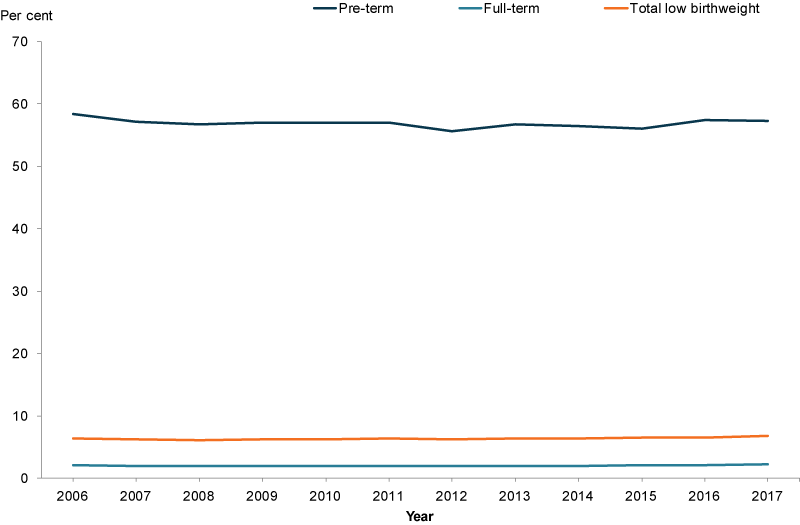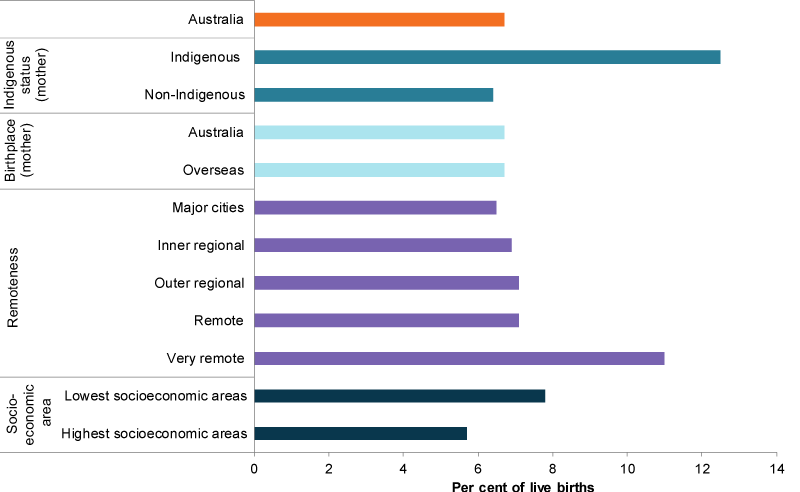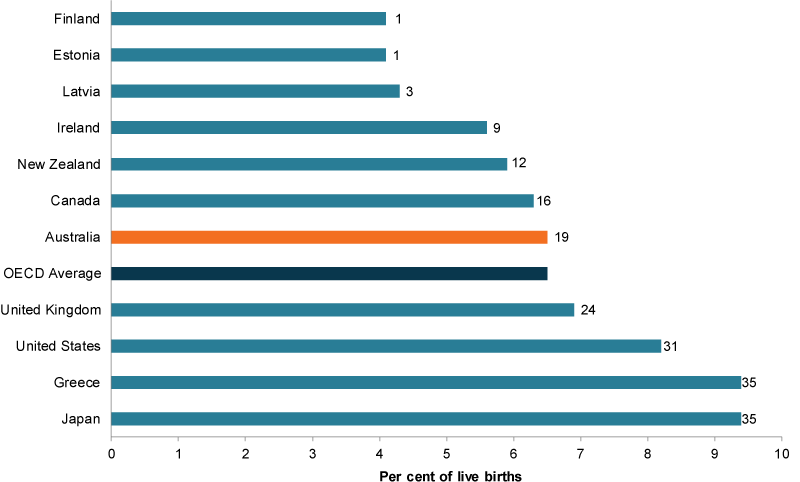What Percent of Babies Are Born 100% Normal
Information updates
25/02/22 – In the Information section, updated data related to birthweight are presented in Information tables: Commonwealth of australia's children 2022 - Health. The web report text was last updated in December 2019.
Key findings
- In 2017, effectually 20,300 (half-dozen.vii%) live-born babies were of depression birthweight (less than 2,500 grams).
- Around fifteen% of low birthweight babies weighed less than ane,500 grams.
- Depression birthweight was college among mothers who smoked during pregnancy (12.ix%) than mothers who did not (6%).
Depression birthweight is a key indicator of a baby's immediate health and a determinant of their future health. Low birthweight babies—whose weight at nascency is less than 2,500 grams—are more than likely to die in infancy or to be at increased run a risk of illness in infancy.
Long-term health effects tin include poor cognitive evolution and increased risk of developing chronic diseases, such every bit diabetes and cardiovascular disease later in life (WHO 2014). Children born with very low birthweight are especially at high risk of developmental difficulties, poor cognitive and motor skills (Scharf et al. 2016). The gamble of dying is greater for babies of very low birthweight (Mayor 2016).
Evidence has found that factors influencing depression birthweight include:
- extremes of maternal historic period (younger than 16 or older than 40)
- multiple pregnancy
- obstetric complications
- chronic maternal atmospheric condition (for example, hypertensive disorders of pregnancy)
- infections (such as, malaria)
- nutritional status
- exposure to indoor air pollution
- tobacco
- drug use (Blencowe et al. 2019).
Research from the Maternal Health Written report conducted in Victoria found that women who experienced family unit violence were twice equally likely to give birth to babies of depression birthweight equally women who did not feel violence (Brown et al. 2015).
Low birthweight is closely associated with pre-term nascency—nearly three in 4 low birthweight babies were pre-term, and more than one-half of pre-term babies were of low birthweight in 2017 (AIHW 2019a).
Babies may besides be low birthweight because they are small for gestational age, while some low-birthweight babies may exist both pre-term and pocket-sized for gestational age. Babies who are pocket-sized for gestational age indicates a possible growth brake within the uterus (see, Where exercise I observe more information?).
While this section focuses on low birthweight, high birthweight is also of business organization. Evidence based on information from 12 loftier, middle and low-income countries indicates that college birthweight was associated with increased odds of obesity among children anile nine–11 (Qiao et al. 2015).
Box 1: Data source on low birthweight babies
Information on birthweight is sourced from the National Perinatal Data Collection (NPDC). The NPDC is a national population-based cross-exclusive collection of data on pregnancy and childbirth. The data are based on births reported to the perinatal data collection in each state and territory in Australia.
How many babies are of low birthweight?
In 2017, around twenty,300 (6.7% of around 303,000) liveborn babies were of depression birthweight. Girls were slightly more likely to exist of low birthweight than boys (vii.3% compared with 6.1%, respectively). Around 15% of depression birthweight babies weighed less than 1,500 grams (AIHW 2019a).
In 2017, the proportion of low birthweight babies was higher among twins (55%) and other multiple nativity babies (99%) compared with singletons (5.two%). It was also college among mothers who smoked during pregnancy (13%) than mothers who did not (half-dozen.0%) (AIHW 2019a).
In 2017, the proportion of pre-term babies of low birthweight was considerably college than that of full-term babies (57% and 2.2%, respectively).
Have depression birthweight rates changed over time?
The proportion of liveborn low birthweight babies was fairly stable in the eleven years to 2017 ranging between vi.1% and half-dozen.vii% (Effigy 1). The proportion of pre-term babies of low birthweight ranged between 56% and 58% during this time, while for full-term babies the rate ranged betwixt 1.9% and two.2%.
Figure 1: Depression birthweight liveborn babies, 2006 to 2017

Chart: AIHW. Source: AIHW NPDC.
Are low birthweight rates the same for everyone?
Low birthweight rates vary across some population groups. In 2017, babies built-in in:
- Very remote areas (xi%) were more likely to be of low birthweight than those built-in in Major cities (vi.5%).
- areas of greatest socioeconomic disadvantage were too more likely to be of depression birthweight (7.eight%) than those born in areas of least disadvantage (5.7%) (Figure 2).
Differences were too evident between babies of Indigenous mothers and those of non-Ethnic mothers (13% and six.4% born of depression birthweight, respectively). The proportion of low-birthweight babies built-in to Indigenous mothers remained relatively stable between 2006 (12.iv%) and 2017 (12.5%). See likewise Indigenous children.
Not all these categories are mutually exclusive. It is likely that some of these influencing factors overlap.
Effigy 2: Low birthweight babies past selected population groups, 2016

Chart: AIHW. Source: AIHW NPDC.
How does Australia compare internationally?
Internationally, Australia's proportion of depression birthweight babies was equal to the Organization for Economic Co-operation and Development (OECD) average (half-dozen.5%). The proportion of low birthweight babies was lowest in Finland and Estonia (4.one% each), and highest in Greece and Japan (9.4% each) (OECD 2018).
Effigy 3: Low birthweight babies past selected OECD countries and rankings, 2016 or latest available

Notes: Information for Canada refer to 2014, and for Australia, to 2015. Exact definitions of low birthweight and of alive births may differ slightly across countries. Data in this graph are for OECD member states only. Graph reflects peak 3 countries, English-speaking groundwork countries, and bottom ranked countries.
Nautical chart: AIHW. Source: OECD Family unit Database.
Data limitations and development opportunities
While low birthweight is both a national and international indicator of babe wellness, it does have limitations as birthweight alone does not account for differentiation in growth status and maturity. Pre-term babies are inherently of low birthweight but may be of normal birthweight for their gestational age (AIHW 2019b).
Where practise I find more information?
For more information on:
- depression birthweight for Indigenous children, run across Indigenous children
- birthweight data, meet: Australia'south mothers and babies 2017—in brief. Data tables and Healthy community indicators.
- low birthweight, see: Low birthweight in Children's Headline Indicators.
- birthweight including adjusted for gestational age, see: Baby outcomes in Australia's mothers and babies data visualisations.
- birthweight of stillborn babies, come across: Australia's mothers and babies 2017—in brief.
- small babies among births at or after 40 weeks gestation, see: National Core Maternity Indicators.
Source: https://www.aihw.gov.au/reports/children-youth/australias-children/contents/health/birthweight
0 Response to "What Percent of Babies Are Born 100% Normal"
Post a Comment